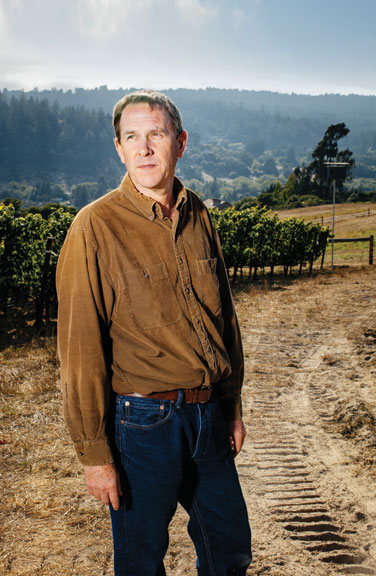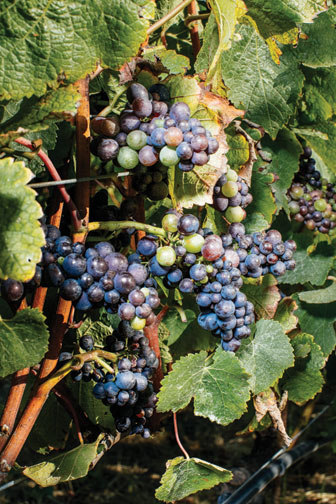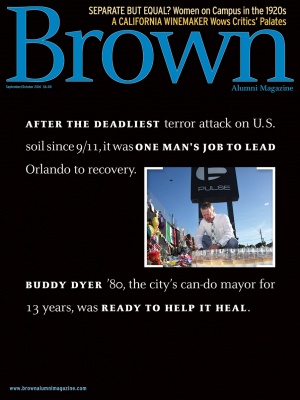On a warm, sunny April afternoon in Sebastopol, California, at the heart of the lush, rolling hills of Sonoma County north of San Francisco, Ted Lemon ’80, in jeans and a green fleece jacket, strides confidently through perfectly aligned and trellised rows of grapevines that are just beginning to sprout tiny buds. By late summer or early fall, these buds will ripen into fat clusters of pinot noir and chardonnay grapes that Lemon and his wife, Heidi, will use to make the wines that have made Littorai, his winery, a favorite among discerning oenophiles.

“It’s early spring,” says Lemon, an affable and somewhat professorial sort who resembles Kevin Costner, “and that means the vines have begun to grow and we’re starting to do things like removing shoots that appear on the wrong parts of the vine and to mow the cover crops, which are good for erosion prevention and also, if they’re leguminous, fix nitrogen in the soil, which of course is important for fertilizing.”
He stops himself, aware, perhaps, of how he can geek out on the science of winemaking. “This is the kind of stuff, of course, you’d learn at Brown only in a bio class.” All this science goes into the making of 4,000 to 6,000 cases a year of Littorai wines (the name means “coasts” in Italian), which sell for between $55 and $85 a bottle. The San Francisco Chronicle’s Jon Bonné, whose palate is revered in the wine world, has called Littorai’s wines “among the purest, most long-lasting expressions of pinot noir and chardonnay in the New World.” Bonné has called Lemon “a true American master” and in 2010 named him Winemaker of the Year.
Littorai wines are at the forefront of what’s sometimes called the “new California wines,” whose restrained expression and high acidity result in wines that are less fruity and alcoholic than traditional wines from the state. Lemon’s approach to his winery is also a study in organic farming and biodiversity. Only three of his thirty acres have been set aside for grape-growing, while the remaining twenty-seven that are not forested are devoted to raising cows and sheep as well as to growing everything from fruit and hay to golden oregano, yarrow, sage, chamomile, and hyssop. On this April day, all those plants give pops of springtime color to the earthy green expanse.
Lemon’s approach to winemaking is called biodynamic farming, in which the goal is to produce as much as possible of what’s needed to grow grapes, from fertilizer to ground cover. With a few other winemakers, Lemon is leading the way in practicing this expanding type of viticulture on the northern California coast.
“We see and treat our farm as a whole,” says Lemon, as we walk by a group of baby Shetland sheep lounging under a large umbrella. Nearby, cows munch on radishes growing in a field, occasionally dropping manure that will fertilize the grape vines. “We operate on the principle that everything we use here must be from the world of the living,” Lemon says. “In other words, no chemicals—or as few as possible. The farm should also be self-sustaining, and we should farm like peasants once did, using our own footsteps to know what’s going on with our land.” The approach, he insists, is responsible for the quality of his vines and the concentration, depth, and complexity of his grapes.
“Ted is doing the platinum standard for sustainable, organic winemaking,” says Marc Capobianco ’81 AM, a Bay Area former mergers-and-acquisitions consultant to the wine industry who’s now aiming to launch Sostevinobile, a San Francisco wine bar that will offer the best West Coast wines. “Have you ever tasted the difference between conventionally grown and organic tomatoes? Extend that difference to wine, and there you go.”
First, of course, comes the grape. Lemon waxes poetic about the pinot noir kind. “It’s one of the most delicate red grape varieties,” he says in a small kitchen inside the winery where he pauses to eat an Asian stir-fry for lunch brought to him by a staffer. “Meaning it has a thin skin and is easily affected by weather. It rots easily. And it makes wine that easily shows flaws in winemaking. If the fermentation goes off-track, if you leave it in the barrel too long . . ..'
Yet it’s that very challenge that has fueled a love affair with the grape that stretches back to Lemon’s years at Brown. Raised in Bedford, New York, by parents who, he says, as members of “the cocktail generation” were far from being oenophiles, Lemon spent a year in France’s Brittany region as part of a high school exchange program. “That’s when I became a Francophile and developed an interest in wine,” Lemon says. “I remember standing in this Muscadet vineyard in the Loire Valley, and the vintner was talking about how winemaking was this amazing synthesis of chemistry, biology, tradition, and agronomy. I thought that was fascinating.”
While concentrating in French literature at Brown, Lemon returned to France, this time to Dijon, which is pinot country. Back in Providence, he sampled affordable Beaujolais or California wines that he bought at Federal Hill Wine and Spirits. He paired them with simple pasta dinners for his housemates, who were both premed.
After graduating, Lemon didn’t know what to do with his degree. Going on to graduate school or entering a field such as international relations held little appeal. Then he remembered that the head of the tourism office in Dijon had told him that if he ever wanted to intern at a regional vineyard he should get in touch. He did just that, returning to France with the help of an Arnold Fellowship from Brown. “I had a hard time finding work, though,” he recalls, “because Mitterrand had just been elected as the first Socialist president since World War II, on a platform of full employment—for the French.”
He finally found a job with Domaine Dujac in Burgundy, “a relatively young family,” Lemon says, “but famous for their wines.” He moved on to a series of jobs that allowed him to learn the entire winemaking process, from trellising and tending vines to cleaning and preparing winery equipment to crushing grapes. He learned how to start the fermenting process in tanks, drain out the liquid, put the solids into a press, and then combine the pressed wine with the original liquids.
His big break came when he became full-time manager for another estate, Domaine Guy Roulot, where he stayed for two years. “To have amid those longstanding traditions a young American managing the place . . .” Lemon’s voice trails off as he ponders his good fortune. Then again, many of the longtime French workers made sure to subject him to various pranks so he didn’t get cocky. “I’d be laying out hoses to move wine from one tank and go back to find the hoses disconnected,” he recalls. “I had to prove that I could work as fast as or faster than anyone else.”
“I would have stayed in France forever happily,” he said. “But because I wasn’t a member of the Roulot family, I couldn’t make the changes I wanted.” He received an offer of work from Chateau Woltner, run by a French family making chardonnay in the Napa Valley. At that time, Lemon says, “Napa still had a lot to learn viticulturally, like spacing the distance between vines, trellising systems. It also had a totally different soil and climate than Burgundy, much warmer yet more frost-prone in the spring, and with soil more on the basic end of the pH spectrum, which changes what nutrients the grapes can take up.”
He stayed at Woltner, which eventually merged with Ladera Vineyards, for seven years, learning much about the business end of winemaking. “Expensive wine is a luxury product and you need to sell it as such,” Lemon reflects. At Woltner, that included getting the wines into the best restaurants, which included the region’s Étoile at Domaine Chandon and at Aureole in New York City. At $55 a bottle, Woltner’s was Napa’s most expensive chardonnay. But the most important thing Lemon learned was that, with wines at that heady price point, “every bottle has to be an ambassador for the brand.” It’s a lesson that would hold him in good stead as he went solo.
In 1989, Lemon met Heidi von Doepp, a Napa local, and the two were married in 1993, the same year they decided to launch Littorai together. “I was part of a group of winemakers, and we would have private tastings,” remembers Lemon, who at that point was consulting for various winemakers in the region. “And we wondered, ‘Where are the great pinot noirs and chardonnays outside of Burgundy?’” The Lemons started small, with $10,000 from Lemon’s consulting work. They used part of it to buy two tons each of pinot and chardonnay grapes from local growers, whose wine-pressing equipment they also used.
“We got that first vintage into some high-end restaurants in San Francisco and New York, plus with some exclusive private clients,” Lemon recalls, “and I plowed that money right back into the business.” The label slowly grew through the 1990s. Then came the key question: where should they grow their own grapes? They settled on hilltop land close to the coast in western Sonoma County, forty miles from Napa. “This was virtually unknown territory for grapes, but we’d tasted some great Sonoma wines,” Lemon says. “And the geological diversity of the coast threw radically different soil types together.” In 2000 they bought ten acres of land and cultivated five. Three years later, with proceeds from the sale of their Napa house, they bought the plot in Sebastopol, starting the biodiverse farm with a family home alongside it. (The couple has three school-age sons.)
Incorporating biodiversity in the winemaking enterprise, especially when wine experts disagree over whether it truly results in a better grape, was a bold statement. “When I moved to Napa,” Lemon says, “it was all synthetic herbicides, like Roundup, and I myself farmed conventionally for twenty years. But I got to a point where I felt like I was at a dead end. In western agronomy, everything’s based on theories of mineral fertilization. If you’re deficient in mineral A, B, or C, correct it. I was doing that but still seeing deficiencies. I said to myself, ‘There must be a different paradigm.’ Organic farming alone was still just a substitution game, as in substituting organic nitrogen for chemical nitrogen. To me, the problem was with the theory.”

So the Lemons decided to raise as much as possible of what they need to grow grapes organically, using the knowledge of past centuries. “We use everything from the pre-scientific world,” Lemon says. “The most radically different part is in the use of preparations. For example, we’ll bury chamomile in the intestines of a cow and put that right in the grape plant or in the compost. This is the hardest part for us to explain to people.” Many observers think there’s something slightly “witchy” about this aspect of biodynamic farming, which was pioneered, somewhat mystically, in the 1920s by the Austrian intellectual Rudolf Steiner.
Lemon acknowledges that he can’t scientifically prove biodynamic techniques make better wines. “But I see a difference in how the vineyard reacts,” he says, “and that’s all I need. At the end of the season, when the plants are getting tired, the biodynamic vines hold their leaves the best, and they have the most evenly maturing fruit. This is about humans learning to work with nature in a non-conflicting way.” Capobianco calls biodynamics “a paradigm shift in California winemaking,” one promoted by In Pursuit of Balance, a consortium of about three dozen vintners, including Lemon.
Lemon may be a valuable player on the California wine scene, but he’s not the only Brown alum in the pack (see sidebar). In fact, the Sunday after my April visit to Littorai, he participated in a wine-tasting event for Bay Area Brown alums, organized by Capobianco, that featured five other alumni vintners and was held at Sebastopol’s popular farm-to-table mecca Zazu Kitchen+Farm, owned by celebrity chef Duskie Estes ’90.
Lemon’s future plans include trying to persuade some of Littorai’s grape growers—the winery still does not grow all its own grapes, which results in different price points for the label—to take up biodynamic methods. He also wants to buy more land in Sonoma. “And,” he says, “we’d like to build underground storage caves for the wine,” which would provide a steady cellar temperature and high humidity. But he has no desire to scale up, at least at the moment. “We’re at a great size right now to be able to continue to push the quality envelope,” he says.
That focus on quality adds up to vintages that, according to Capobianco, fall on the upper-middle bracket of California wine exclusivity. By contrast, the cabernet sauvignon produced by former telecom entrepreneur Chuck McMinn ’74—Capobianco calls his winery “one of the most technologically sophisticated wineries in California”—tops out at more than $200 a bottle. But don’t look for either man’s product at your local liquor store.
Lemon, like McMinn, sells about 95 percent of his wine through a private mailing list. Lemon’s list has grown from a few hundred members in 1993 to several thousand today. Back in April, as he finishes his lunch, he’s preparing to give a tour and tasting (which are by appointment only) to some new visitors, who might very well end up on that mailing list.
Before he can greet them, he is interrupted by Eric Pignal, a thirty-year-old blond Frenchman from Burgundy who in a bit of irony is apprenticing at Littorai. Pignal asks if he should bring the cows in from the pasture.
“Leave them,” Lemon says. “I really want them to eat those radishes.” The radishes, after all, will end up as nutrients in compost, which will in turn feed his grapes.
“Also,” Pignal says, “there is a wild duck stuck in there with the sheep. Should I put a little plywood fence around her to protect her?”
“Yeah,” Lemon says. “And make sure everyone has water.”
Such are the daily responsibilities behind running a self-sustaining vineyard. “We’re just on the cusp of understanding what the new world of the Anthropocene era will be,” he says, referring to the current epoch in which humans have begun to impact the planet in profound ways that are not yet fully known. “And we’re seeing some early success in this vineyard.”
Tim Murphy ’91, who writes on politics, culture, and LGBT issues, is the author of the new novel Christodora.






